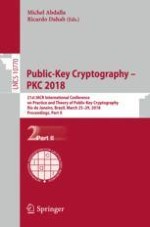2018 | OriginalPaper | Buchkapitel
Attribute-Based Signatures for Unbounded Circuits in the ROM and Efficient Instantiations from Lattices
verfasst von : Ali El Kaafarani, Shuichi Katsumata
Erschienen in: Public-Key Cryptography – PKC 2018
Aktivieren Sie unsere intelligente Suche, um passende Fachinhalte oder Patente zu finden.
Wählen Sie Textabschnitte aus um mit Künstlicher Intelligenz passenden Patente zu finden. powered by
Markieren Sie Textabschnitte, um KI-gestützt weitere passende Inhalte zu finden. powered by
